Truck Freight
Truck Freight
A freight truck transports things from one place to another. The truck’s body is built around a strong chassis and a powerful engine to easily carry heavier loads. Usually, they transport cargo between warehouses, factories, wholesalers, and retailers. Almost anything being transported interstate or overseas will be on a truck at some point.
Freight trucks come in different types ranging from small pickups and semi-trailers that haul small to large goods to heavy haulers that can handle oversized cargo.
7 types of Trucking Services We offer (and what they haul)
These are the most popular types of freight trucks and what they can carry.
Flatbed freight truck
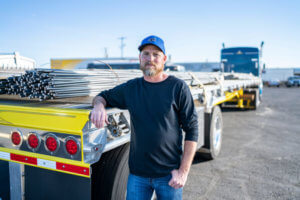 True to its name, a flatbed freight truck has a flat open trailer attached to the back of the truck with no sides or roof. Flatbeds can transport oversized loads that are too wide for a truck with an enclosed trailer. It also makes for easier loading and unloading. Straps or other devices tie the cargo down securely to the bed.
True to its name, a flatbed freight truck has a flat open trailer attached to the back of the truck with no sides or roof. Flatbeds can transport oversized loads that are too wide for a truck with an enclosed trailer. It also makes for easier loading and unloading. Straps or other devices tie the cargo down securely to the bed.
Able to haul up to 48,000 pounds, flatbed trucks are popular with transportation and logistics companies because they’re so versatile. They’re ideal for construction materials, machinery, cars, and other oversized cargo. Some also have extendable flatbeds to fit cargo that’s too long for a standard flatbed trailer.
Step deck freight truck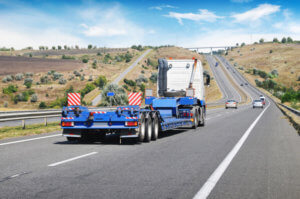
A step deck freight truck, also known as drop deck or lowboy trailer, is similar to a flatbed truck. The only difference is that the trailer bed has two decks. Tall and oversized goods usually go on the lower deck.
Since the load will ride lower, a step deck freight truck can easily clear low bridges, even with a tall load. The lower ground clearance also makes loading and unloading easier. There are even double drop trailers that have a well in the middle to carry tall freight along with front and back decks for other goods.
One of the biggest advantages of step deck trailers is you can move tall cargo without any additional permits.
Reefer freight truck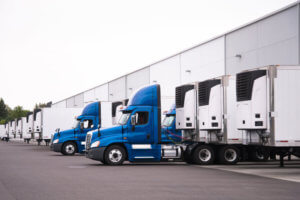
A reefer freight truck AKA refrigerated truck is designed to carry perishables and other goods that need proper temperature control. The refrigerated compartment is either mounted directly onto the truck’s frame or attached separately as a trailer. The refrigeration unit sits at the front of the trailer or above the truck’s cab.
Reefers also come with a control unit so you can adjust the container temperature. They most commonly transport food, medical supplies, cold drinks, and other perishable cargo.
Reefers are more expensive to operate because they use more fuel than a non-refrigerated truck.
Dry van freight truck
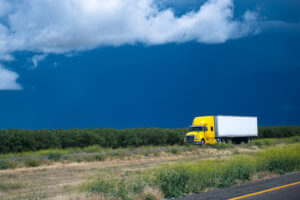 Dry vans are one of the most popular freight trucks. Dry vans have an enclosed, non-temperature-controlled trailer attached to them. The sealed trailer protects the contents from the elements and any other potential transportation damage. Unlike flatbed trailers that can carry oversized goods, dry vans are generally used for large loads of palletized, boxed, or loose cargo.
Dry vans are one of the most popular freight trucks. Dry vans have an enclosed, non-temperature-controlled trailer attached to them. The sealed trailer protects the contents from the elements and any other potential transportation damage. Unlike flatbed trailers that can carry oversized goods, dry vans are generally used for large loads of palletized, boxed, or loose cargo.
Dry van freights can also carry cars, machines, and any other large equipment that can fit inside an enclosed trailer. Demand for these freight trucks is usually pretty high, so your chances of getting dry van jobs are higher, too.
Box freight truck
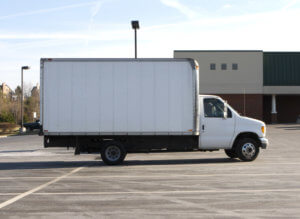 Also known as a cube truck, a box freight truck gets its name from its box-shaped cargo compartment. The cargo box sits on a frame and is usually separate from the truck’s cabin. But some box trucks do have a door between the cab and cargo area.
Also known as a cube truck, a box freight truck gets its name from its box-shaped cargo compartment. The cargo box sits on a frame and is usually separate from the truck’s cabin. But some box trucks do have a door between the cab and cargo area.
Box trucks come in different sizes and are typically used to move home appliances and furniture, transport packages, and deliver food.
Tanker freight truck
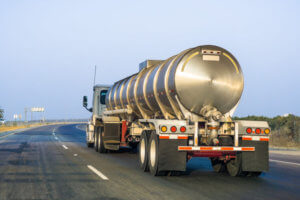 Tanker freight trucks carry liquids and gases. The truck pulls a cylindrical tank mounted on a semi-trailer. Tanker trucks are commonly used to transport fuel and other liquids such as milk, wine, juices, and industrial chemical fluids.
Tanker freight trucks carry liquids and gases. The truck pulls a cylindrical tank mounted on a semi-trailer. Tanker trucks are commonly used to transport fuel and other liquids such as milk, wine, juices, and industrial chemical fluids.
Depending on the fluid, the cylindrical tank can be refrigerated or non-refrigerated, insulated or non-insulated, and pressurized or non-pressurized. The tanks themselves have internal compartments to carry multiple loads as well as reduce the liquid sloshing.
Note: Tanker trucks can be difficult to operate and require skilled drivers behind the wheel to minimize liquid sloshing inside the tank.
Semi-trailer freight truck
 A semi-trailer truck has a semi-trailer with no front axle or front wheels. Instead, the trailer front rests on a “fifth-wheel” coupling, also known as the hitch of the truck. The trailer also comes with legs and wheels that you can lower for support when unhooked from the truck. A truck can also pull one or two additional trailers, known as doubles and triples, that can carry very large cargo over long distances.
A semi-trailer truck has a semi-trailer with no front axle or front wheels. Instead, the trailer front rests on a “fifth-wheel” coupling, also known as the hitch of the truck. The trailer also comes with legs and wheels that you can lower for support when unhooked from the truck. A truck can also pull one or two additional trailers, known as doubles and triples, that can carry very large cargo over long distances.
Semi-trailer trucks also have many different names. Some of the more popular are 18-wheeler, big rig, tractor-trailer, and semi-truck.
Industries served
- Consumer goods
- Food & Beverage
- Electronics
- Pet Transport
- Shipping Conatiners
Services offered
- Shared warehousing
- Crossdocking/Transloading
- FBA Preaparation

Cargo Insurance
Business Analytic
Box Checking
A freight truck transports things from one place to another. The truck’s body is built around a strong chassis and a powerful engine to easily carry heavier loads. Usually, they transport cargo between warehouses, factories, wholesalers, and retailers. Almost anything being transported interstate or overseas will be on a truck at some point.
Freight trucks come in different types ranging from small pickups and semi-trailers that haul small to large goods to heavy haulers that can handle oversized cargo.
7 types of Trucking Services We offer (and what they haul)
These are the most popular types of freight trucks and what they can carry.
Flatbed freight truck
 True to its name, a flatbed freight truck has a flat open trailer attached to the back of the truck with no sides or roof. Flatbeds can transport oversized loads that are too wide for a truck with an enclosed trailer. It also makes for easier loading and unloading. Straps or other devices tie the cargo down securely to the bed.
True to its name, a flatbed freight truck has a flat open trailer attached to the back of the truck with no sides or roof. Flatbeds can transport oversized loads that are too wide for a truck with an enclosed trailer. It also makes for easier loading and unloading. Straps or other devices tie the cargo down securely to the bed.
Able to haul up to 48,000 pounds, flatbed trucks are popular with transportation and logistics companies because they’re so versatile. They’re ideal for construction materials, machinery, cars, and other oversized cargo. Some also have extendable flatbeds to fit cargo that’s too long for a standard flatbed trailer.
Step deck freight truck
A step deck freight truck, also known as drop deck or lowboy trailer, is similar to a flatbed truck. The only difference is that the trailer bed has two decks. Tall and oversized goods usually go on the lower deck.
Since the load will ride lower, a step deck freight truck can easily clear low bridges, even with a tall load. The lower ground clearance also makes loading and unloading easier. There are even double drop trailers that have a well in the middle to carry tall freight along with front and back decks for other goods.
One of the biggest advantages of step deck trailers is you can move tall cargo without any additional permits.
Reefer freight truck
A reefer freight truck AKA refrigerated truck is designed to carry perishables and other goods that need proper temperature control. The refrigerated compartment is either mounted directly onto the truck’s frame or attached separately as a trailer. The refrigeration unit sits at the front of the trailer or above the truck’s cab.
Reefers also come with a control unit so you can adjust the container temperature. They most commonly transport food, medical supplies, cold drinks, and other perishable cargo.
Reefers are more expensive to operate because they use more fuel than a non-refrigerated truck.
Dry van freight truck
 Dry vans are one of the most popular freight trucks. Dry vans have an enclosed, non-temperature-controlled trailer attached to them. The sealed trailer protects the contents from the elements and any other potential transportation damage. Unlike flatbed trailers that can carry oversized goods, dry vans are generally used for large loads of palletized, boxed, or loose cargo.
Dry vans are one of the most popular freight trucks. Dry vans have an enclosed, non-temperature-controlled trailer attached to them. The sealed trailer protects the contents from the elements and any other potential transportation damage. Unlike flatbed trailers that can carry oversized goods, dry vans are generally used for large loads of palletized, boxed, or loose cargo.
Dry van freights can also carry cars, machines, and any other large equipment that can fit inside an enclosed trailer. Demand for these freight trucks is usually pretty high, so your chances of getting dry van jobs are higher, too.
Box freight truck
 Also known as a cube truck, a box freight truck gets its name from its box-shaped cargo compartment. The cargo box sits on a frame and is usually separate from the truck’s cabin. But some box trucks do have a door between the cab and cargo area.
Also known as a cube truck, a box freight truck gets its name from its box-shaped cargo compartment. The cargo box sits on a frame and is usually separate from the truck’s cabin. But some box trucks do have a door between the cab and cargo area.
Box trucks come in different sizes and are typically used to move home appliances and furniture, transport packages, and deliver food.
Tanker freight truck
 Tanker freight trucks carry liquids and gases. The truck pulls a cylindrical tank mounted on a semi-trailer. Tanker trucks are commonly used to transport fuel and other liquids such as milk, wine, juices, and industrial chemical fluids.
Tanker freight trucks carry liquids and gases. The truck pulls a cylindrical tank mounted on a semi-trailer. Tanker trucks are commonly used to transport fuel and other liquids such as milk, wine, juices, and industrial chemical fluids.
Depending on the fluid, the cylindrical tank can be refrigerated or non-refrigerated, insulated or non-insulated, and pressurized or non-pressurized. The tanks themselves have internal compartments to carry multiple loads as well as reduce the liquid sloshing.
Note: Tanker trucks can be difficult to operate and require skilled drivers behind the wheel to minimize liquid sloshing inside the tank.
Semi-trailer freight truck
 A semi-trailer truck has a semi-trailer with no front axle or front wheels. Instead, the trailer front rests on a “fifth-wheel” coupling, also known as the hitch of the truck. The trailer also comes with legs and wheels that you can lower for support when unhooked from the truck. A truck can also pull one or two additional trailers, known as doubles and triples, that can carry very large cargo over long distances.
A semi-trailer truck has a semi-trailer with no front axle or front wheels. Instead, the trailer front rests on a “fifth-wheel” coupling, also known as the hitch of the truck. The trailer also comes with legs and wheels that you can lower for support when unhooked from the truck. A truck can also pull one or two additional trailers, known as doubles and triples, that can carry very large cargo over long distances.
Semi-trailer trucks also have many different names. Some of the more popular are 18-wheeler, big rig, tractor-trailer, and semi-truck.